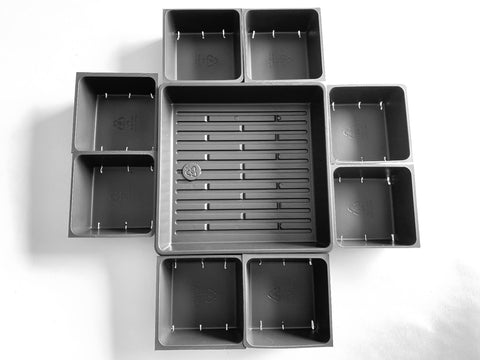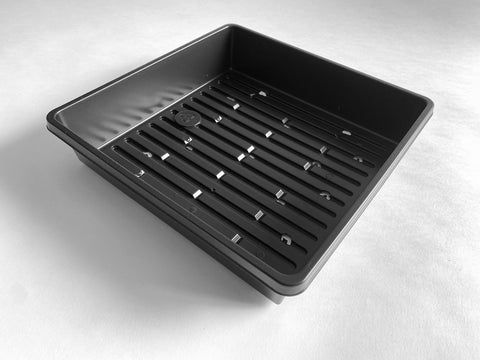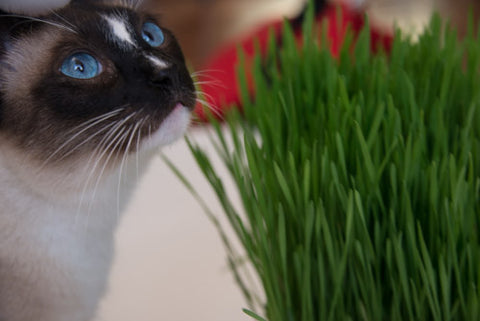

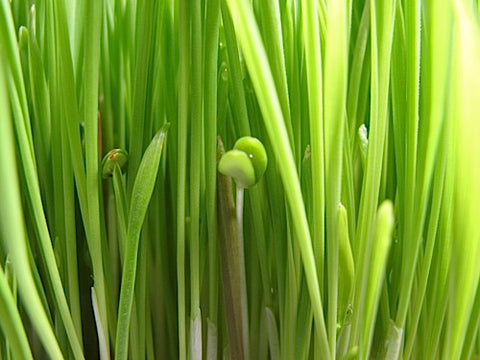

Cat Grass
Wheat, Oats, Rye, Barley, Flax
Salad for your all pets! Our special non-puking formula has pleased many thousands of cats and cat people since 1993. It has also pleased rabbits, dogs, guinea pigs, iguanas, turtles and many more of our other-than-human friends.
Vitamins A, B, C, E and K
Calcium, Chlorophyll, Iron, Lecithin, Magnesium, Pantothenic Acid
Amino Acids, Trace Elements, Phosphorus, Potassium
Protein: up to 30%
The time it takes to grow a finished 6 - 10 days, or other crop (Micro-Greens, Grass, Greens) from a dry Seed. Note: This "finished" Sprout is our preference. you may grow them for as long as you want! In fact, we suggest that you taste them at every rinse to discover when you like them best.
How to Grow Cat Grass
- Soak 1/4 cup of seed in cool water for 6-12 hours.
- Drain off soak water. Do not ever soak again.
- Rinse thoroughly.
- Drain thoroughly.
- Rinse and Drain with cool water every 8-12 hours until your seeds have the tiniest root showing.
- Plant on a thoroughly moistened medium, in a tray.
- Cover your crop with another tray or plate, to keep light out and moisture in.
- Keep your medium moist by watering lightly as needed. Don't drench!
- When your Grass is 4-12 inches tall - feed uncut to your Cat or other friends and family.

Dry Seed awaiting Soaking

12 hours later... After Soaking, Rinsing and Draining well.

12 hours later... Another Rinse/Drain cycle. These are perfect for planting. They are just barely sprouted.

12 hours later... If you kept sprouting, instead of planting, you're still good. Don't wait any longer to plant them. give 'em another Rinse and spread them atop that which you are growing on.

Planted atop whatever....

12 hours later - look at all those Root Hairs.

12-24 hours later.

24 hours later.

24 hours later.
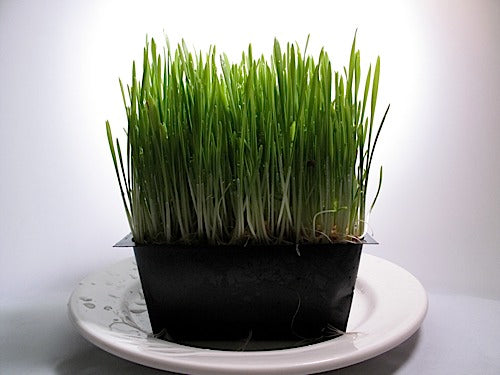
24 hours later.

24 hours later.

24 hours later.

24 hours later.

24 hours later. Don't make your kitty wait any longer =:-)

Dry Seed awaiting Soaking

12 hours later... After Soaking, Rinsing and Draining well.

12 hours later... Another Rinse/Drain cycle. These are perfect for planting. They are just barely sprouted.

12 hours later... If you kept sprouting, instead of planting, you're still good. Don't wait any longer to plant them. give 'em another Rinse and spread them atop that which you are growing on.

Planted atop whatever....

12 hours later - look at all those Root Hairs.

12-24 hours later.

24 hours later.

24 hours later.

24 hours later.

24 hours later.

24 hours later.

24 hours later.

24 hours later. Don't make your kitty wait any longer =:-)
Yields approximately 4 Cups (1/2 lb.) of Sprouts
Seed Prep
Measure out 2 Tablespoons of seed* (slightly heaping) into your Sprouter or a strainer.
Rinse your seeds to remove dust and debris.
Soak
Transfer your seeds into your Sprouter (if necessary), or to a bowl.
Mix seeds up as you slowly add water to assure even water contact for all.
Add 2-3 times as much cool (70-80°F) water.
Allow seeds to Soak for 4-12 hours.
Do Not Ever Soak Again. Soaking is done only this one time.
We start counting days at this point - when the Soak is done (post-Soak is the phrase we use).
A crop of Leafy Sprouts usually takes 6 days - from This point in time to harvest.
Sprouting
Empty the seeds into your Sprouter (if necessary).
Drain off the soak water.
You can use it - it has nutrients in it. We use it on house plants.
Rinse thoroughly with cool (70-80°F) water.
Drain thoroughly.
Draining Thoroughly (Maniacally even) is the key to great crops. The smaller the seed (all Leafy Sprouts are small seeds) the more thorough you must be. Do Not skimp on Rinsing - but focus seriously on Draining.
If you need to see what we mean by Thorough Draining - check out our videos.
Set your Sprouter anywhere out of direct sunlight and at room temperature (70° is optimal) between Rinses.
This is where your sprouts do their growing. We use a counter top - in the corner of our kitchen, where the sprouter won't get knocked over by cats, dogs, kids or us. Indirect sunlight is fine, as is your regular room light - because light just does not matter much in the first couple days.
A plant can only perform photosynthesis when it has leaves. Until a plant has leaves, light has little if any effect. Sprouts also happen to like air-circulation, so don't hide your sprouts. When leaves do appear, this will be plenty of light for them to green up. You can also use Grow Lights if you like.
Rinse and Drain again every 8-12 hours for 3 days.
Always be sure to Drain very thoroughly. The most common cause of inferior sprouts is inadequate drainage. Even the best designed Sprouting Device holds water, so pay special attention to this step.
Greening
On the 4th day (post soak) relocate your sprouts, if necessary.
If you've been keeping them away from light - move them. Avoid direct sun as it can cook your sprouts, unless you are growing in a Tray Sprouter - in which case direct sunlight is great. Indirect sunlight is best for non-tray Sprouters but grow lights work well too. Experiment - you will be amazed at how little light sprouts require to green up. Photosynthesis is a marvel!
Continue to Rinse and Drain thoroughly every 8-12 hours.
Your last Rinse and Drain will be either at the end of day 5 or the start of day 6.
Always Drain Thoroughly.
Finishing
Your sprouts will be done about the end of day 6.
The majority of sprouts will have open leaves which will be green. You'll recognize them.
De-Hulling
Hulls are the thin coat on a seed. In most cases they separate themselves from the sprout. They are only a problem when it comes to the shelf life of your finished crop. We've eaten them for years and consider them extra roughage, but the crop looks better and lasts longer without them - so removing them is good.
You may De-Hull your sprouts at any time during day 5 or 6.
If you have a Salad Spinner - De-Hulling can be your last step. You can harvest and refrigerate them immediately after you finish.
You can also remove hulls prior to harvest...
If you are growing in a Jar - using the Coarse Mesh Screen will allow some hulls to float out through the screen while Rinsing. Repeating and agitating your sprouts will allow more hulls to escape.
If you're growing in an Easy Sprout Sprouter - transfer your sprouts to the Solid Base, fill with water, and agitate with a fork. This will help hulls get to the surface - where you can skim them off. When you've gotten all you can - move your sprouts back to the Growing Vessel, Rinse again, and Drain Thoroughly.
If you're growing in our Stainless Steel Sprouter you can get rid of most of the hulls by Rinsing Upside Down. Instead of writing words - let us direct you to our short video on the subject: Rinsing Leafy Sprouts Upside Down
Here is our video on De-Hulling.
Harvest
If you De-hulled with a salad spinner - you can go right to refrigeration. If not... Your sprouts are done 8-12 hours after your final Rinse and Very Thorough Draining. If we minimize the surface moisture of our sprouts they store much better in refrigeration, so we let them sit for 8-12 hours after that final Maniacal Draining.
Storing Your Crop
Transfer your sprout crop to a plastic bag or the sealed container of your choice. We have Produce Storage Bags that can extend shelf life substantially.
Leafy Sprouts are best within a week of harvest, but we've had some crops last for over a month in the fridge.
Great work sprout farmer!
*Amount of Seed to Use
* If using Sproutpeople's Single Harvest Pack - use the whole bag (for a one-quart Sprouter). It will produce a crop of approximately 8 ounces.
These seeds yield approximately 7:1 - which means the sprouts will weigh 7 times as much as the seed you start with, but, they will increase even more in volume - so don't start with more than 2 (heaping) Tablespoons per quart/litre of sprouter capacity.
Grass for cats, salad for cats (and kittens, and a plethora of other creatures), whatever you call it - it is really amazing stuff! Cats and other creatures need vegetable matter in their diet, just like people, and Kat Grass supplies that along with great nutrition. We even include a little Flax which is good for their coats. Many of you know that your cats need this, because they eat your house plants - that is the surest sign that your cat will love this treat. Cat Grass is easily grown - on soil or a soilless medium - like Hemp Felt. All you do to serve your cat (etc.) is to place the container of living grass near their food dish or in some other place they'll find it.
Wheat is best stored in a cool location - at home, we keep ours in a freezer. There is no need to thaw your seed before Soaking.
Planting Density
The more densely you plant the seed the less air circulates around the individual blades of Grass. This can cause some fungal growth - we call it “fuzzies”. This is not a problem, except that it is unattractive. If you are consuming this as juice - just rinse it off when you harvest the Grass. If you hate it - increase air flow by planting less seed. Additionally, you may move your Grass to a better ventilated area. In summer we grow our Grass outside (from the point when we uncover the tray) for optimal air circulation.
Planting Medium
We grew Grass - on soil - in Trays, for over 20 years. But, we now have alternatives: Soilless mediums - Coconut Coir - our all-time favorite - and Hemp Felt - a thin organic material that you soak before planting upon. Hemp Felt holds moisture well and when used with organic liquid Kelp Fertilizer, is the cleanest (least messy) way to grow strong crops. Coconut Coir is more like soil. It holds moisture phenomenally well and provides nutrients as needed to your growing crop. Used in conjunction with Earthworm Castings it is the perfect medium!
You will notice in our Video - A Time Lapse: Wheatgrass Growing that we used only a piece of Hemp Felt on a plate. So, obviously that too is possible. We don't have this method in our instructions, but if you want to do it - all you need to do - in addition to following the rest of our instructions - is to water FREQUENTLY. I pumped a Spray Bottle thousands of times over the course of that time-lapse @:-)
Soil Notes
Virtually any soil will do for Grass. We used sterile bagged soil (usually composted cow manure) when we were professional growers, but any sterile bagged soil will do. You can find some at your local garden center. You can use expensive soil if you prefer - it is your choice - always. Of course Organic is best, but it is usually quite costly.
The amount of soil you use is up to you. The reality is this: As your plants grow they need more and more water. They get their water from the soil. The more soil you use - the more water it can hold = the less frequently you need to water.
Hydroponic Grass
We do not grow hydroponic Grass - we've tried but have never gotten the yields we get with soil. Now that we have a soilless alternatives like Coconut Coir and Hemp Felt we are even less interested in hydroponic Grass growing, but there is a theoretical plus to growing Grass without a medium - you can juice the entire crop - grains, roots and grass, so if you want to try - go for it! Go to Val at Go Green/Green Smoothie - she is the meister of hydroponic Grass. Tell her us Sproutpeople sent you!
Tray Notes
Your Planting Tray (the one with the medium in it) MUST have drainage holes or slits! Nothing will grow well in a medium that can not drain - that condition is commonly called "flooded". We do use the Drip Tray to hold some water at times in the growing process. (see instructions - in the Growing Instructions tab).
As I've said elsewhere on the site, we hate dogma, so take my dogma with a grain of salt. You can grow in trays without drainage (the amazing people at the Hippocrates Health Institute have long done so), but you do have to be able to drain excess water away. Tipping is a possibility, but we think it risky - especially for the novice grower, hence my dogma.
Going for "Split Blades"
There are some who maintain that Grass doesn't reach its full nutritional value until its blades "split" - or a second blade grows. It is pretty difficult to grow Grass this big in a small container. It usually wilts before it can do this, but it is possible. Just keep your crop moist and examine the blades of Grass - from day 8 on - to see if they are "splitting". It happens low on the blade - within the first inch or so above the medium. Harvest as soon as you see the split.
As always, we think it is most essential that you enjoy what you grow. The more you like what you grow, the more you'll want to consume it. Whenever you consume it - it will have a whole lot of nutritional value. If you prefer it younger (we do), stop and harvest according to our instructions. If you want to grow it more, go for it. It's all great!
If you are going for this, we advise that you plant on mix of 75% Coconut Coir enriched with 25% Earthworm Castings, which adds a lot of nitrogen for the Grass to draw upon. Nitrogen is the nutrient a plant needs to put on green growth.
Re-Growing Your Crop
Grass can produce a 2nd and even 3rd crop - so you may continue to water after you cut your first crop. The 2nd and (more so) the 3rd crop will not be as tender, nor usually as tall, but it is good to try growing at least a 2nd crop. Decide for yourself if it is worth it! Coconut Coir is the best medium, as far as water retention is concerned - if you want to go for multiple cuttings, but Coir or soil enriched with Earthworm Castings is perhaps a better choice as it gives the Grass nutrients to draw upon. Whatever you use, it's worth a try if only for the experience.
Re-Using your Medium
Do NOT try to re-use your Growing Medium. You just need to start over when you plant a new crop. We have a short Video on the subject =:-)
Recommended Sprouters for Cat Grass
I have 2 indoor ragdolls who have been eating the Cat Grass for years, they eat it as soon as they wake up before breakfast. Also if ever they have been upset in their tummies, they would eat it and feel more tranquil. The grass is consistently tender and healthy, I can not recommend it enough!
Soaking seeds now.
Thank you so much.
Our cat Tina Turner **loves** this! We always have some out for her to eat whenever she wants. Thanks for making it so easy!
I am a long time customer. No place is better. Great personalized customer service. Seeds are great and the price is one of the best. Very happy with everything about this company.
My cats like this grass better than the grass I’d buy at the store. It’s also cheaper to buy it by the lb versus a pre bagged bag of seed from pet stores. My dog likes it too and it does not make her throw up like the other seed I was buying.


